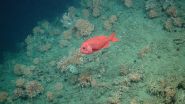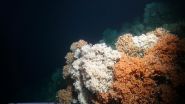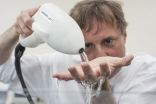(Press-News.org) The first true three-dimensional picture of submarine canyon habitats has been produced using a unique combination of marine robotics and ship-based measurements. The information captured in this new set of maps ranges in scale from the 200km canyon down to the size of an individual cold-water coral polyp, and will be used to inform the management of the only English Marine Conservation Zone in deep water.
This 'nested map' is the result of a recent scientific expedition to the Whittard Canyon in the Bay of Biscay, led by the National Oceanography Centre (NOC). It works in a way not unlike a set of Russian dolls, with the most detailed map sitting within a larger scale one, which sits within a larger map still.
Submarine canyons are some of the most complex deep-sea environments on this planet, and are known to be potential biodiversity hotspots. Similar to canyons on land, submarine canyons can have steep flanks, with vertical cliffs and overhanging rock formations. Until recently these parts were out of reach for traditional types of marine equipment, which made them the 'forgotten habitats' of the deep sea. By using unique robot technology to collect data in these 'hard-to-reach' areas, the results of this expedition will lead to a better understanding of the biodiversity patterns in the canyon and of the processes that drive them.
Echo-sounders on the RRS James Cook were used to create a 200km map of the canyon with a 50m pixel resolution. Using a newly-developed sideways-directed echo-sounder, the Autosub6000 robot-sub, maintained by the NOC, was able to map vertical walls within the canyon with a resolution of 3-5m per pixel. At the same time Isis, the NOC-maintained Remotely Operated Vehicle, was lowered from the RRS James Cook on a tether to record high definition video and to collect biological and geological samples from vertical and overhanging locations. Echo-sound data collected with Isis was also used to create the most detailed map of the three, with a resolution of 10-20cm.
Dr Veerle Huvenne from the NOC, who led the 5-week expedition, said: "Our robot vehicles imaged rich communities of cold-water corals, clams, deep-sea oysters and their associated fauna, including a broad range of fish species. We also captured amazing footage of Blue Sharks and Swordfish when the Isis marine robot was travelling to and from the seabed.
The morphology of this canyon is spectacular. We have mapped cliffs up to 150m high and 1.6km long, in some locations down to centimetre-scale resolution. This makes us the only group in the world who currently can image vertical cliffs in the deep sea in this way. "
The Whittard Canyon proved to be a highly dynamic environment, with strong internal tidal flows and containing deep plumes of organic-rich sediment. To study these oceanographic processes, the University of East Anglia's robot glider was used to continuously measure the water column. Tahmeena Aslam, who was responsible for the glider from UEA, said: "Our Seaglider collected a fantastic dataset and revealed the presence of internal waves up to 80 m high; these processes are likely to have a major influence on the distribution of habitats and fauna within the canyon".
INFORMATION:
The expedition was part of the CODEMAP project, funded by the European Research Council, and received additional support from the NERC MAREMAP programme and DEFRA. Participants included researchers from NOC, University of East Anglia, University of Southampton, CEFAS, the British Geological Survey, IFREMER, National University of Ireland, Galway, and University of Aveiro.
ROCHESTER, Minn. - Mayo Clinic researchers have identified a protein marker whose frequency may predict patient response to PD-1 blockade immunotherapy for melanoma. An abstract of their findings was presented today at the American Association for Cancer Research International Cancer Immunotherapy Conference in New York City.
"The discovery of biomarkers of sensitivity are vital not only for informing clinical decisions, but also to help identify which patients with melanoma, and possibly other malignancies, who are most likely to benefit from PD-1 blockade," says Roxana ...
The oil and gas extraction method called hydraulic fracturing remains controversial for multiple reasons, one of which is its water use. But, as scientists report in ACS' journal Environmental Science & Technology Letters, water requirements for the process are potentially lower than those for some other energy-related extraction methods.
Since oil and gas companies ramped up hydraulic fracturing, or fracking, to unlock oil and gas from shale and tight oil formations, reports of earthquakes and contaminated water near wells proliferated. Some environmental experts have ...
Detecting breast cancer in women with dense mammary tissues could become more reliable with a new mammogram procedure that researchers have now tested in pre-clinical studies of mice. In their report in the journal ACS Nano, they describe injecting gold nanoparticles in mammary tissue to enhance the imaging of early signs of breast cancer.
Mammography remains the clinical gold standard of screening tests for detecting breast cancer. However, a recognized limitation of this X-ray procedure is that dense breast tissue shows up as white masses and fibers on an image, ...
Citizen science is taking off and could make a difference at regional and national regulatory levels. But not everyone thinks that's a good idea. The cover story of Chemical & Engineering News (C&EN), the weekly newsmagazine of the American Chemical Society, delves into the progress of the budding movement, as well as the pushback.
Steven K. Gibb, senior editor at C&EN, reports that in some states, regulators actively encourage and support local residents' participation in environmental monitoring. For example, Maryland's Department of the Environment and Department ...
Fossils tell amazing stories and inspire them, too -- just think of this summer's "Jurassic World" blockbuster. But because some of the processes that preserve fossils are not well understood, there's still more information that they could reveal. Now scientists report in ACS' journal Analytical Chemistry a new way to probe fossils to find out how these ancient remains formed in greater detail than before.
When most organisms die, they biodegrade and leave little behind. But if they get trapped in sediments that harbor few bacteria and loads of dissolved minerals, they ...
Coughing. A sore throat. Maybe a pain in your chest as you take a deep breath.
These are all common symptoms for many city-living Australians when smog levels are high. And while it is well understood that smog can cause such problems, new research has for the first time given us a glimpse as to what might be happening at the molecular level.
The University of Melbourne's Professor Richard O'Hair, from the School of Chemistry's Bio21 Institute, in collaboration with Professor Stephen Blanksby (from the Queensland University of Technology and formerly the University ...
Researchers from the University of Southampton have demonstrated how a pioneering ultrasonic device can significantly improve the cleaning of medical instruments and reduce contamination and risk of infection.
StarStream, invented and patented by the University of Southampton and in commercial production by Ultrawave Ltd., makes water more efficient for cleaning by creating tiny bubbles which automatically scrub surfaces. The device supplies a gentle stream of water through a nozzle that generates ultrasound and bubbles, which dramatically improve the cleaning power of ...
This news release is available in German.
Platinum is a great catalyst and can be used for many different applications. It's expensive stuff though, so tiny platinum nanoparticles sitting on cheap metal oxide materials are used to convert harmful carbon monoxide into carbon dioxide. Using scanning tunnelling microscopes, scientists at TU Vienna have now been able to image the catalytic behaviour of platinum sitting on iron-oxide, which allowed them to explain the process on an atomic scale. Surprisingly, the chemical reactions do not take place on the platinum ...
Researchers at the University of Birmingham have shown how the development of coated silica nanoparticles could be used in restorative treatment of sensitive teeth and preventing the onset of tooth decay.
The study, published in the Journal of Dentistry, shows how sub-micron silica particles can be prepared to deliver important compounds into damaged teeth through tubules in the dentine.
The tiny particles can be bound to compounds ranging from calcium tooth building materials to antimicrobials that prevent infection.
Professor Damien Walmsley, from the School of ...
This news release is available in German.
Topical research experiments are often too expensive or too complex to be rebuilt and incorporated in teaching. How can one, nevertheless, make modern science accessible to the public? This challenge was tackled in the research group Quantum Nanophysics led by Markus Arndt at the University of Vienna. For the first time, two research laboratories were created as complete, photorealistic computer simulations allowing university and high-school students as well as the general public to virtually access unique instruments. ...




